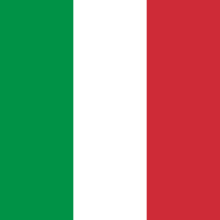Cisalpine Republic

The Cisalpine Republic (contemporary spelling; next to it modern Cisalpine Republic ; Italian Repubblica Cisalpina ) was an Italian subsidiary republic established by French revolutionary exports on June 29, 1797 , which was formed from the predecessor states Cispadan Republic and Transpadan Republic . It was renamed the Italian Republic ( Italian Repubblica Italiana ) on January 26, 1802 and dissolved on March 17, 1805 by incorporation into the newly created Kingdom of Italy .
Surname
The name of the republic is derived from the Latin word cis for this side ; the Cisalpine Republic was thus the republic on this side of the Alps from the Italian point of view. In addition, the choice of name alluded to the ancient name Gallia Cisalpina for northern Italy along the Po River .
Size and economy
The state with the capital Milan encompassed Lombardy with Mantua , Bergamo , Brescia and Cremona , Verona and Rovigo , the Duchy of Modena , the principalities of Massa and Carrara and the legations of Bologna, Ferrara and Mesola together with Romagna , since October 22, 1797 as well nor the formerly Grisons subject area Valtellina with Bormio and Chiavenna. There were also efforts to incorporate the Italian-speaking parts of Switzerland , then known as the Helvetic Republic and, like the Cisalpine Republic, a subsidiary of France.
From 1797 the Cisalpine Republic covered around 42,500 km² with 3.24 million inhabitants and was divided into 20 departments . The capital Milan , in which at times up to 25,000 French occupation soldiers lived, was the most populous city with 124,000 inhabitants, followed by Bologna and Ferrara . It was an economically prosperous country that lived mainly from agriculture, but also from cattle and silk worms. In addition, there was the traditional handicraft and the growing silk industry , as well as the sale of wood from the Alps and marble from the Apennines.
history
After the victories against Austria in the Northern Italian campaign of 1796/1797, which were decisive for the outcome of the First Coalition War , Napoleon proclaimed the Cisalpine Republic on June 29, 1797 by uniting the Cispadan and Transpadan republics that had only been created the previous year.
Napoleon dissolved the previous Austrian administrative structures and set up a provisional military administration which, among other things, was entrusted with collecting the war contributions . The first constitution followed the example of the French Republic, furnished with an already in 1796 under the French military administration and Directorate -called five-man executive and a two-chamber legislature of 240 members, the Senate and the Great Council . The highest state power, however, lay with the French commander-in-chief in Lombardy, Napoleon Bonaparte.
Relations between the Cisalpine Republic and Switzerland were initially strained by permanent cisalpine attempts to annex the Italian-speaking Swiss areas in Ticino south of the Alps. The aim was to establish a nation-state based on the French model with the same language and culture. In the years 1810 to 1813 Napoleon had the Ticino occupied by Italian troops and customs officials in order to prevent the increasing smuggling and desertions from the army.
Austria recognized the new state in the Peace of Campo Formio of October 1797, but invaded the country at the beginning of the Second Coalition War in May 1799 and abolished the republic. Bonaparte's victory at Marengo the following year restored the original conditions. The Peace of Lunéville in 1801 confirmed the existence of the Cisalpine Republic, which had received a second, new constitution with a unicameral legislature ( Consulta ) and a nine-member executive ( Governo ). On January 26, 1802, it changed its name to the Italian Republic , adopted the French consular constitution and elected Napoléon Bonaparte as president. On March 17, 1805, Napoléon, Emperor of the French since December 1804 , accepted the crown of the Kingdom of Italy and dissolved the Italian Republic.
Flags and national colors
The national colors of today's Italian state correspond to the Cisalpine or Italian Republic. The flag of the Cisalpine Republic, a tricolor flag , was not officially adopted until May 11, 1798 and had vertical stripes. The Transpadanic forerunner republic also used standards with vertical stripes. The flag of the Italian Republic corresponded to the cisalpine tricolor until August 20, 1802. In a text by the then Minister of War Trivulzi it says:
“At my suggestion, the government approved the change of the national flag on water and on land. Thus, the new country flag is square with a red background. It bears a white rhombus, which in turn contains a green square. The flag is identical on water, but rectangular. The symbol on warships should be a pennant in the appropriate colors. The infantry brigades and the cavalry regiments should use the same colors in the same pattern on their standards. "
When Napoleon Bonaparte was appointed King of Italy on March 17, 1805, the national flag was not changed. The royal coat of arms was only added to the reverse of the war and most military flags. The Italian national movement of the Risorgimento , which emerged around the middle of the 19th century, took up the tricolor of the Cisalpine Republic again and made it the flag of Italian unification.
Trivia
In the 1990s and 2000s, the Swiss Federal Railways and the Italian Trenitalia marketed some express trains between Switzerland and northern Italy under the name Cisalpino .
literature
- Peter Leonhard Zäslin: Switzerland and the Lombard State in the Revolutionary Age 1796-1814 . 1960.
Web links
- Marco Dubini: Cisalpine Republic. In: Historical Lexicon of Switzerland .
Individual evidence
- ↑ a b c d e Marco Dubini: Cisalpine Republic. In: Historical Lexicon of Switzerland . July 1, 2010 , accessed June 5, 2019 .
- ^ A b Flags of the world - Italy. Retrieved May 17, 2010 .







